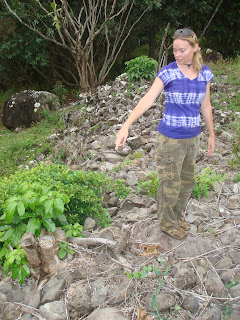 Sponsored by international cultural
studies department, over 30 students from class anthropology 105 and
peace-building major were able to visit Hau’ula for an archaeological
investigation and a community service to the Maunawila Heiau – an ancient Hawaiian religious site on October 13.
Sponsored by international cultural
studies department, over 30 students from class anthropology 105 and
peace-building major were able to visit Hau’ula for an archaeological
investigation and a community service to the Maunawila Heiau – an ancient Hawaiian religious site on October 13. The visit was led by BYU-H professions Rebekah Walker, Special Instructor of ICS, and Tevita Ka’ili, Associate Profession in anthropology. Explained the purpose of the service was to “help the anthropology 105 students to learn more about the native Hawaiian sacred site”, said Ka’ili. “We are anthropologists….it is important we learn in the field,” he said. “We were not there to restore but to clear the site. So we can study the stone….. Students are very respectful and enjoy learning more about Hawaiian culture.”
A Heiau is a place of worship which made out of stone structure. Ancient Hawaiian believed the Heiau can make the medicine powerful, so it was also a place of healing and to make medicine for the chief. Ancient Hawaiian visited the Heiau when life went wrong.
 Today, this Maunawila Heiau is no longer in use. Some native Hawaiians in
Hua’ula were interested in restoring their ancient culture, tradition, and
religion; therefore, BYUH-H was contacted with the chance to serve and to visit
the sacred Heiau, according to Ka’ili.
Today, this Maunawila Heiau is no longer in use. Some native Hawaiians in
Hua’ula were interested in restoring their ancient culture, tradition, and
religion; therefore, BYUH-H was contacted with the chance to serve and to visit
the sacred Heiau, according to Ka’ili.
Professor Rosanna Runyon Thurman, Archeologist
from University
of Hawaii, and two more Archeologists
were invited to direct the Heiau investigation.
She offered a lecture to BYU-H students before the visit and guided students to
clean the site. Thurman guessed the Maunawila
Heiau was used to be a healing Heiau,
but the structure was too old that she could not find any evidence to support
her assumption.
Thurman did not find any Ki’i either around the Heiau. Ki’i is a wood or stone carving of god that ancient Hawaiian used
for protection purpose. Each Heiau is
protected by a particular god in the form of Ki’i, according to Ka’ili.
“I'm glad I made the decision to go because I would have missed out on some first hand archaeological experience,” said Briar Kaanga, an English Junior from Hau’ula. “I was never actually motivated to put that preservation [of culture] into action. I'm kind of nonchalant about things until it affects me, but now I can see the toll ignorance can take on a dying culture, practice or religion. All three can relate to everyone in this world [because] they helped to shape and educate us.”
Mark Levi, a biology
and exercise science senior from Washington,
said he went to the service mainly for class credits; however, “it impressed me
how little is known about the area. There is only speculation from
archeologists regarding certain areas of the Heiau and what they may have been used for, but nothing certain.”

No comments:
Post a Comment